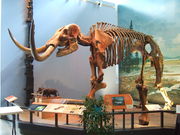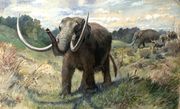Mastodon
| Mastodon Fossil range: 34–0 Ma |
|
|---|---|
 |
|
| Mounted mastodon skeleton, Museum of the Earth . | |
| Scientific classification | |
| Kingdom: | Animalia |
| Phylum: | Chordata |
| Class: | Mammalia |
| Order: | Proboscidea |
| Family: | †Mammutidae Hay, 1922 |
| Genus: | †Mammut Blumenbach, 1799 |
| Species | |
|
|
| Synonyms | |
|
|
Mastodons (Greek: μαστός "breast" and οδών, "tooth") were large tusked mammal species of the extinct genus Mammut which inhabited Asia, Africa, Europe, North America and Central America from the Oligocene through Pleistocene, 33.9 mya to 11,000 years ago.[1] The American mastodon is the most recent and best known species of the group. Confusingly, several genera of proboscids from the gomphothere family have similar-sounding names (e.g., Stegomastodon) but are actually more closely related to elephants than to mastodons.
The genus gives its name to the family Mammutidae, assigned to the order Proboscidea. They superficially resemble members of the proboscidean family Elephantidae, including mammoths; however, mastodons were browsers while mammoths were grazers.
Contents |
History and distribution
Mastodons first appeared almost 40 million years ago; the oldest fossil (Mastodon sp.) was unearthed in the Democratic Republic of the Congo. Fossils have also been found in England, Germany, the Netherlands, North America, Romania[2] and northern Greece.
Description

While mastodons had a size and appearance similar to elephants and mammoths, they were not particularly closely related. Their teeth differ dramatically from those of members of the elephant family; they had blunt, conical, nipple-like projections on the crowns of their molars,[3] which were more suited to chewing leaves than the high-crowned teeth mammoths used for grazing; the name mastodon (or mastodont) means "nipple teeth" and is also an obsolete name for their genus.[4] Their skulls are larger and flatter than those of mammoths, while their skeleton is stockier and more robust.[5]
Species
American mastodon

The American mastodon (Mammut americanum), the most recent member of the family, lived from about 3.7 million years ago until it became extinct about 10,000 years BCE. It is known from fossils found ranging from present-day Alaska and New England in the north, to Florida, southern California, and as far south as Honduras.[6] The American mastodon resembled a woolly mammoth in appearance, with a thick coat of shaggy hair.[7] It had tusks that sometimes exceeded five meters in length; they curved upwards, but less dramatically than those of the woolly mammoth.[5] Its main habitat was cold spruce woodlands, and it is believed to have browsed in herds.[8] They are generally reported as having disappeared from North America about 10,000 years ago,[9] as part of a mass extinction of most of the Pleistocene megafauna. Paleo-Indians entered the American continent in relatively large numbers 13,000 years ago,[10] and their hunting may or may not have contributed to a gradual attrition of the mastodon population.[11]
Other species

Mammut cosoensis was endemic to North America, from the Pliocene, living from 4.9—1.8 mya, existing for approximately 3.1 million years.[12] Pliomastodon cosoensis was named by Schultz (1937). Its first fossil location is the Coso Mountains in California. It was recombined as Mammut cosoensis by Shoshani and Tassy (1996).[13][14]
Mammut furlongi was endemic only to North America and from the Miocene living from 23.03—5.33 mya, existing for approximately 17.7 million years.[15] Mammut furlongi was named by Shotwell and Russell (1963). Its first fossil location is Black Butte, a Miocene terrestrial horizon in the Juntura Formation of Oregon.[16]
Mammut raki was endemic to North America from the Pliocene, living from 4.9—1.8 mya, existing for approximately 3.1 million years.[17] Mastodon raki was named by Frick (1933). Its type locality is Elephant Butte Reservoir, New Mexico. It was recombined as Mammut raki by Tedford (1981) and Lucas and Morgan (1999).[18][19]
Mammut spenceri was endemic to North America from the Miocene, living from 16.9—16 mya, existing for approximately 0.9 million years.[20]
Mammut spenceri was named by Fourtau (1918). Its type locality is Wadi Moghra, Egypt.[21]
Current excavations

Excavations conducted from 1993 through early 2000 at the Diamond Valley Lake reservoir outside of Hemet in Riverside County, California yielded numerous remains of mastodon, as well as numerous other Pleistocene animals. The abundance of these remains, all recovered by paleontologists from the San Bernardino County Museum, led to the site being nicknamed the "Valley of the Mastodons".
Current excavations are going on annually at the Hiscock Site in Byron, New York, for mastodon and related paleo-Indian artifacts. The site was discovered in 1959 by the Hiscock family while digging a pond with a backhoe; they found a large tusk and stopped digging. The Buffalo Museum of Science has organized the dig since 1983. There were also excavations at Montgomery, New York in the late 1990s.
In July 2007, a team of Greek and Dutch paleontologists excavated the longest mastodon tusks in the world in Milia, a village near Grevena. The tusks each measure 5 meters long, and weigh 1 ton. Experts believe that the mammal was a 25–30 year-old male, 3.5 meters tall and weighed approximately 6 tons.[22][23]
In August 2008, miners in Romania unearthed the skeleton of a 2.5 million-year-old mastodon, believed to be one of the best preserved in Europe.[24] Ninety percent of the skeleton's bones were intact, with damage to the skull and tusks.[24] In 2009 a family in Portland, Michigan unearthed mastodon bones while excavating a new pond on their property. It is one of approximately 250 mastodons found in Michigan over the past century.[25]
As of July 2009, six mastodon fossils were discovered in Elmacık village, in Burdur province, Turkey. Also the first excavation to discover mastodon fossils took place in Elmacik village in 2006.[26]
In August 2009, workers in Indiana, while digging a coal-slurry storage pit, unearthed mastodon remains. These remains include pieces of ribs, skull, tusks, and a kneecap. The remains were turned over to the Indiana State Museum for study and preservation.[27]
See also
- Island 35 Mastodon
- Coats-Hines Site
- List of museums and colleges with mastodon fossils on display
References
- ↑ PaleoBiology Database: Mammut, basic info
- ↑ 2.5 million-year-old mastodon unearthed in Romania
- ↑ Mastodons
- ↑ Agusti, Jordi and Mauricio Anton (2002). Mammoths, Sabretooths, and Hominids. New York: Columbia University Press. pp. 106. ISBN 0-231-11640-3.
- ↑ 5.0 5.1 Kurtén and Anderson, p. 345
- ↑ Polaco, O. J.; Arroyo-Cabrales, J.; Corona-M., E.; López-Oliva, J. G. (2001). "The American Mastodon Mammut americanum in Mexico". In Cavarretta, G.; Gioia, P.; Mussi, M. et al.. The World of Elephants - Proceedings of the 1st International Congress, Rome October 16–20, 2001. Rome: Consiglio Nazionale delle Ricerche. pp. 237–242. ISBN 88-8080-025-6
- ↑ Palmer, D., ed (1999). The Marshall Illustrated Encyclopedia of Dinosaurs and Prehistoric Animals. London: Marshall Editions. pp. 124. ISBN 1-84028-152-9.
- ↑ Palmer, D., ed (1999). The Marshall Illustrated Encyclopedia of Dinosaurs and Prehistoric Animals. London: Marshall Editions. p. 243. ISBN 1-84028-152-9.
- ↑ "Greek mastodon find 'spectacular'". BBC News. 24 July 2007. http://news.bbc.co.uk/2/hi/europe/6913366.stm. Retrieved 2007-07-24.
- ↑ Beck, Roger B.; Linda Black, Larry S. Krieger, Phillip C. Naylor, Dahia Ibo Shabaka, (1999). World History: Patterns of Interaction. Evanston, Illinois: McDougal Littell. ISBN 0-395-87274-X.
- ↑ Ward, Peter (1997). "The Call of Distant Mammoths".
- ↑ PaleoBiology Database: Mammut cosoensis, basic info
- ↑ J. R. Schultz. 1937. Carnegie Institution of Washington Publication 487
- ↑ J. Shoshani and P. Tassy. 1996. Summary, conclusions, and a glimpse into the future. in J. Shoshani and P. Tassy, eds., The Proboscidea: Evolution and Palaeoecology of Elephants and Their Relatives 335-348
- ↑ PaleoBiology Database: Mammut furlongi, basic info
- ↑ J. A. Shotwell and D. E. Russell. 1963. Transactions of the American Philosophical Society 53
- ↑ PaleoBiology Database: Mammut raki, basic info
- ↑ R. H. Tedford. 1981. Geological Society America Bulletin 92
- ↑ S. G. Lucas and G. S. Morgan. 1999. New Mexico Geology 21
- ↑ PaleoBiology Database: Mammut spenceri, basic info
- ↑ R. Fourtau. 1918. Contribution a l'Étude des Vertébrés Miocènes de l'Égypt 1-109
- ↑ Scientists present longest prehistoric Mastodon tusks ever found in the world and model, Reuters, Jan 2008, Retrieved on 04 September 2009
- ↑ Remains of mastodon discovered in Grevena, Kathimerini, 24 July 2007, Retrieved on 04 September 2009
- ↑ 24.0 24.1 2.5 million-year-old mastodon unearthed in Romania, USA Today, 2008-08-08, Retrieved on 11 August 2008
- ↑ "Michigan Family Finds Prehistoric Bones - Mastodon Bones To Be Given To University Of Michigan". The Associated Press. July 2, 2009. http://www.clickondetroit.com/news/19932305/detail.html. Retrieved 3 July 2009.
- ↑ "Mastodon Fossils Discovered In Burdur/Turkey". Yerbilimleri. July 17, 2009. http://www.yerbilimleri.com/burdurda-mastudon-fosilleri-bulundu. Retrieved 17 July 2009.
- ↑ "NEW: Mastodon remains found 30 miles south of Terre Haute". TribStar.com. 18 August 2009. http://www.webcitation.org/query?url=http%3A%2F%2Ftribstar.com%2Flocal%2Fx1896315752%2FNEW-Mastodon-remains-found-30-miles-south-of-Terre-Haute&date=2010-05-02. Retrieved 2 May 2010.
External links
- The Rochester Museum of Science - Expedition Earth Glaciers & Giants
- Illinois State Museum - Mastodon
- Calvin College Mastodon Page
- American Museum of Natural History - Warren Mastodon
- BBC Science and Nature:Animals - American mastodon Mammut americanum
- BBC News - Greek mastodon find 'spectacular'
- Paleontological Research Institute - The Mastodon Project
- Missouri State Parks and Histroric Sites - Mastodon State Historic Site
- Saint Louis Front Page - Mastodon State Historic Site
- The Florida Museum of Natural History Virtual Exhibit - The Aucilla River Prehistory Project:When The First Floridians Met The Last Mastodons
- Worlds longest tusks
- Western Center for Archaeology & Paleontology, home of the largest mastodon ever found in the Western United States
- Smithsonian Magazine Features Mammoths and Mastodons